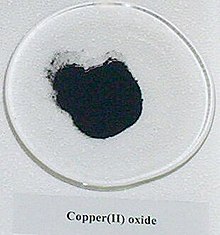
Back Koper(II)oksied Afrikaans أكسيد النحاس الثنائي Arabic Mis (II)oksid Azerbaijani Меден оксид Bulgarian কিউপ্রিক অক্সাইড Bengali/Bangla Òxid de coure(II) Catalan Oxid měďnatý Czech Kobber(II)oxid Danish Kupfer(II)-oxid German Óxido de cobre(II) Spanish

| |

| |

| |
| Names | |
|---|---|
| IUPAC name
Copper(II) oxide
| |
| Other names
Cupric oxide
| |
| Identifiers | |
3D model (JSmol)
|
|
| ChEBI | |
| ChEMBL | |
| ChemSpider | |
| ECHA InfoCard | 100.013.882 |
| EC Number |
|
PubChem CID
|
|
| RTECS number |
|
| UNII | |
CompTox Dashboard (EPA)
|
|
| |
| |
| Properties | |
| CuO | |
| Molar mass | 79.545 g/mol |
| Appearance | black to brown powder |
| Density | 6.315 g/cm3 |
| Melting point | 1,326 °C (2,419 °F; 1,599 K) |
| Boiling point | 2,000 °C (3,630 °F; 2,270 K) |
| insoluble | |
| Solubility | soluble in ammonium chloride, potassium cyanide insoluble in alcohol, ammonium carbonate |
| Band gap | 1.2 eV |
| +238.9·10−6 cm3/mol | |
Refractive index (nD)
|
2.63 |
| Structure | |
| monoclinic, mS8[1] | |
| C2/c, #15 | |
a = 4.6837, b = 3.4226, c = 5.1288 α = 90°, β = 99.54°, γ = 90°
| |
| Thermochemistry | |
Std molar
entropy (S⦵298) |
43 J·mol−1·K−1 |
Std enthalpy of
formation (ΔfH⦵298) |
−156 kJ·mol−1 |
| Hazards | |
| GHS labelling: | |

| |
| Warning | |
| H410 | |
| P273, P391, P501 | |
| NFPA 704 (fire diamond) | |
| Flash point | Non-flammable |
| NIOSH (US health exposure limits): | |
PEL (Permissible)
|
TWA 1 mg/m3 (as Cu)[2] |
REL (Recommended)
|
TWA 1 mg/m3 (as Cu)[2] |
IDLH (Immediate danger)
|
TWA 100 mg/m3 (as Cu)[2] |
| Safety data sheet (SDS) | Fisher Scientific |
| Related compounds | |
Other anions
|
Copper(II) sulfide |
Other cations
|
Nickel(II) oxide Zinc oxide |
Related compounds
|
Copper(I) oxide |
Except where otherwise noted, data are given for materials in their standard state (at 25 °C [77 °F], 100 kPa).
| |
Copper(II) oxide or cupric oxide is an inorganic compound with the formula CuO. A black solid, it is one of the two stable oxides of copper, the other being Cu2O or copper(I) oxide (cuprous oxide). As a mineral, it is known as tenorite. It is a product of copper mining and the precursor to many other copper-containing products and chemical compounds.[3]
- ^ The effect of hydrostatic pressure on the ambient temperature structure of CuO, Forsyth J.B., Hull S., J. Phys.: Condens. Matter 3 (1991) 5257–5261, doi:10.1088/0953-8984/3/28/001. Crystallographic point group: 2/m or C2h. Space group: C2/c. Lattice parameters: a = 4.6837(5), b = 3.4226(5), c = 5.1288(6), α = 90°, β = 99.54(1)°, γ = 90°.
- ^ a b c NIOSH Pocket Guide to Chemical Hazards. "#0150". National Institute for Occupational Safety and Health (NIOSH).
- ^ Richardson, H. Wayne (2002). "Copper Compounds". Ullmann's Encyclopedia of Industrial Chemistry. Weinheim: Wiley-VCH. doi:10.1002/14356007.a07_567. ISBN 978-3527306732.
© MMXXIII Rich X Search. We shall prevail. All rights reserved. Rich X Search
